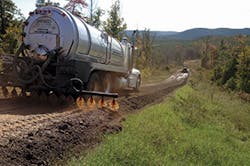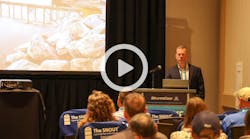Erosion Control at Oil and Gas Drilling Sites
In an effort to expand their businesses, many erosion and sediment control contractors have turned to providing services to the oil and gas drilling and hydraulic fracturing sites. Services can include dust control on unpaved access roads, sediment control, revegetation of disturbed areas, and other measures to protect habitat and wetlands.
While all erosion and sediment control jobs require correct product use for the given application, attention to safety, and adherence to regulations, these factors are often amplified at oil and gas drilling sites. The work also can be subject to market and seasonal fluctuations.
A significant amount of drilling and hydraulic fracturing takes place in Pennsylvania, including in the Marcellus Shale region. Pennsylvania’s Code for environmental protection includes a chapter, Chapter 102, dealing with earth-disturbing activities. These regulations are used by the Pennsylvania Department of Environmental Protection’s Office of Oil and Gas Management for regulating construction of oil and gas well sites, access roads, and other facilities.
=The Office of Oil and Gas Management has a special permit, the Erosion and Sediment Control General Permit (ESCGP-2), that has been in place since 2012 following its 2009 predecessor, ESCGP-1.
The permit is similar to an NPDES permit for stormwater, but tailored for the oil and gas industry, explains Stephen Brokenshire, environmental group manager for the office’s Bureau of Planning and Program Management.
There are two different types of oil and gas sites. One involves conventional vertical well drilling on sites that are usually less than 5 acres. The other is the newer, unconventional shale drilling site, horizontal drilling operations that usually take place on sites larger than 5 acres.
The first action an operator must take is obtaining a well permit, “because they cannot start building well pads everywhere and plan on drilling on them sometime in the future,” says Brokenshire. “They have to get the well permit first before they can do anything.”
The well permits have specific notification requirements, notes Brokenshire. “They have to notify anybody who has a water well or water supply within a certain perimeter. They also have to notify the hosting municipality and adjoining municipalities to that site.”
In conjunction with the permit, the operator gets an ESCGP-2 permit. Any construction activity that encroaches on any surface water or wetlands also requires a Title 25 PA Code Chapter 105 general permit, a permit for activities such as putting a temporary bridge over a stream, placing wood matting to move equipment across wetlands, or installing culverts in a stream or a pipeline crossing under a stream.
The ESCGP-2 is all-encompassing, says Brokenshire. “They have to do the Pennsylvania Natural Diversity Inventory [PNDI] search, an inventory of all of the state or federal endangered species and threatened species, a Pennsylvania Natural Heritage Program search for historical sites, and they have to map the soils and surface waters. They have to do a complete search of the area that they plan to disturb. They have to notify municipalities of their activities and develop an erosion and sediment control plan and a post-construction stormwater management/site restoration plan,” he says.
Companies also must have a Preparedness, Prevention, and Contingency (PPC) plan, emergency response plan, and containment plan.
“In our Oil and Gas Act of 2012, there are requirements that they have to take containment measures for specific industrial products and waste products. They also have to employ erosion and sediment control best management practices,” says Brokenshire.
Oil and gas companies operating in an exceptional-value or high-quality watershed have to use higher-standard BMPs, known as ABACT (antidegradation best available combination of technologies).
“When they’re in a normal cold-water or warm-water fishery watershed, they have to design for a two-year, 24-hour rain event, whereas when they’re in a high-quality or exceptional-value watershed, they have to design for a five-year, 24-hour rain event with more robust BMPs,” notes Brokenshire. “We have higher standards in the high-quality watersheds in Pennsylvania.”
Additionally, larger projects require post-construction stormwater BMPs to restore the water quality and runoff rates to pre-existing conditions, notes Vincent Yantko, mineral resources program specialist for the bureau.
“They have to maintain the same runoff coefficient,” adds Brokenshire. “After a certain amount of time when they’re done drilling, the clock begins that they have to restore that site and scale the pad back, because those pads may be there for the next 25 to 50 years, especially if they’re going to start drilling other target formations. As a result, they are required to put post-construction stormwater management BMPs in, and they’re obligated to maintain them for as long as that well pad is there.”
The comprehensive Erosion and Sediment Pollution Control Manual, which was updated in March 2012, outlines all the BMPs the state’s engineers have reviewed and approved.
“We don’t require it, but we encourage people to use our E&S control manual so that the BMPs are already there for them,” says Brokenshire. “If we know they’re using them, then we’re confident in their performance. It’s in our regulations that it is recommended when they’re developing an erosion and sediment control plan, they use the manual.”
The state allows for the use of emerging technologies and a combination of technologies, “but they have to prove their effectiveness,” says Brokenshire. “Normally they follow the manual because they know there usually won’t be any questions.”
Contractors are permitted to use water and natural wood polymer for dust control on the unpaved access roads to the drilling sites. The state often receives complaints of mud tracking out onto the main roads from the pipeline areas.
“We typically require them to get some equipment in there to brush the dirt and mud that tracks off the site and take it back up on to the site, not just brush it off to the side of the road,” says Yantko.
The most common problems the Pennsylvania DEP employees see on oil and gas sites are improper erosion and sediment control BMP installation and maintenance.
“I won’t say it’s a routine violation, but it’s one that we do see quite often,” says Yantko. “Some subcontractors are not well versed on properly installing the E&S BMPs. It’s amazing how complicated silt fence can be to some people.
It actually has to be trenched into the ground.
“I call what they do sometimes ‘ring around the rosie’—which means they just put a line of silt fence in a complete circle around the project and they don’t understand the concept that it has to be parallel to the terrain.”
Failure to install E&S BMPs properly can create a problem that’s more significant than the one the BMP is supposed to protect against, points out Yantko.
“Instead of controlling the sediment runoff from the site, you can actually funnel the water and cause a bigger erosion problem by not installing them properly,” he says.
“One of the most important criteria in the Chapter 102 regulations for these BMPs is a self-regulating program, where these operators are supposed to inspect these controls weekly and after each stormwater event,” says Brokenshire. “If that’s done and these inspections are done properly, everything should run smoothly.”
As for the conventional well sites on less than 5 acres, they are required only to have an erosion and sediment plan when they disturb more than 5,000 square feet. Typically, the sites are under an acre.
“Sometimes there’s practically a zero footprint if they’re a really good well driller who can drill a well with very little earth disturbance,” says Brokenshire. “They don’t have to get a full blown ESCGP-2 permit, only a well permit. They are still required to get a Chapter 105 general permit if they’re encroaching within 50 feet of water or going to cross it.
“An encroachment permit has its own erosion and sediment control plan requirements,” he adds. “A very sensitive area, the water or wetland, gets its own E&S plan and the permit itself has its own criteria for the permitted activity. It’s like a permit within a permit for those operators conducting earthmoving activities near water.”
Controlling Dust
Jason Ramsey and Brian Coleman met in 2009 while working for an oilfield service company and two years later formed their own company, Ramco Environmental. Among their many services, they provide dust control for the oil and gas sector.
Ramco Environmental provides its services through an office in Arkansas to serve that state, as well as in Texas and Oklahoma, and an office in Ohio serving that state and West Virginia and Pennsylvania.
The company’s dust control applications are mostly on unpaved access roads to remote drilling sites, including unpaved county roads or township roads leading to the oil and gas sites. About 25% of the work is done on lease roads constructed by the oil and gas companies, says Ramsey.
They use PennzSuppress, an emulsified resin product used for dust control, soil stabilization, and erosion control. Created for use in and around sensitive habitats, it is designed to control dust by up to 98%.
Because Ramco Environmental provides services in several states, Ramsey and Coleman have to stay abreast of the particular state regulations with respect to work on oil and gas sites. Much of their work is in providing dust control in buffers around bridges and waterways.
“It seems that everybody follows the Penn State Center for Dirt and Gravel Road Studies recommendations,” says Ramsey. “PennzSupress is approved by them.”
The Center for Dirt and Gravel Road Studies is an independently funded, nonprofit entity under the Larson Transportation Institute at Penn State specializing in education, outreach, research, and project oversight related to environmentally sensitive maintenance of unpaved roads and trails.
“As long as there is a state approval letter, so far we haven’t run into any kind of rules that say how it needs to be applied or that it’s to be applied in an environmentally responsible manner to reduce the type of runoff,” says Ramsey. “The regulations have been pretty vague. They rely on us as operators and applicators to do what’s right.”
For Ramco Environmental, that means if there is a 50–60% chance of rain for the day, “we’re not going to send our trucks out, because it doesn’t make sense for the chance of the material to run off,” says Ramsey. “If a customer is paying for the road and it’s not going to have enough time to cure and get set up properly, there’s no sense in us doing it.”
How the product is applied is just as important as what product is used, says Ramsey.
“Just because you’ve got a good product—which PennzSuppress is—if you don’t do it the right way, you can mess some things up,” says Ramsey. “We’re very careful in selecting the operators who actually put the material out and who know how to treat the roads. There’s an art to it. Not every road is the same. Sometimes we have to make decisions based on the conditions of the road that we’ve been dispatched to treat.”
The product is applied more quickly on compacted roads so the material doesn’t puddle up and run off. A road that’s been freshly bladed means the product will be applied more slowly, enabling it to absorb better.
Ramsey agrees with the observations of the Pennsylvania Department of Environmental Protection that one of the biggest problems on oil and gas drilling sites is track-out issues from unpaved roads.
“If someone is driving on unstabilized roads after a significant amount of rain, they’re going to track all of that mud and dirt onto a paved road, and once it dries there are dirt clots and rough roads. There are potholes in the untreated roads, so it does create a mess,” he says.
“We feel we can help with that problem, because if we stabilize or treat a road—not just for dust control but over time with several applications—that road becomes a hard, durable surface, reducing the tracking issue with mud. And when it does get hot and dry, it’s basically gluing that roadway together.”
Without proper treatment, fines and larger aggregate are lost during a storm and the road integrity is decreased, Ramsey points out. He says he favors PennzSuppress for its ability to stop migration during a rain event.
“There are a lot of roads we treat and the water will shear off, and when it’s back to dry, the dust control is still down,” he says. “It stays on the road where it’s supposed to and doesn’t end up in ditch lines, creeks, and ponds.”
In one project, Ramco Environmental helped ARG Resources stay in compliance.
“We were doing some work in the Allegheny National Forest due to several oil and gas operators’ activities there. When they are building these roads and making new locations, they were having problems during the rain events,” says Ramsey. “The rain was taking that sediment and putting it into the creeks, which was affecting the drinking water supply.”
In May 2014 when ARG Resources was building its roads, Ramco Environmental applied PennzSuppress to stabilize the roadways to reduce erosion and sediment loss within the Allegheny National Forest.
“They were under a Pennsylvania Department of Protection order to get that under control, so we helped them come into compliance to protect the waters of the state and of the national forest,” says Ramsey. “It’s an ongoing project, and the results have been successful. They’ve come into compliance and they’ve been happy with the application service and with PennzSuppress.”
Seeding the Drilling Pads
TeRo Enterprises is a hydroseeding contractor based in Oklahoma and Texas that offers services to the energy sector nationwide. The company uses Finn HydroSeeders ranging from 1,200- to 3,300-gallon units. Services include hydroseeding and hydromulching using Profile Products’ Flexterra.
The company does seeding work in the Eagle Ford Formation in south Texas and for BHP Billiton in the Permian Basin, which covers western Texas and southeastern New Mexico.
“We follow around the construction sites and inspection crews, seeding the pads before they drill,” says Wayne Woodward, general manager with TeRo Enterprises. “We’re working with civil engineers on the construction pads, trying to get the pads all contained and seeded before the drill crews get on them.” In general, a well pad covers 3–5 acres.
Because the work is done on private land, ranchers often set the rules for what they want the oil companies to do, says Woodward. “But with the BHP Billiton development group, I’m using their product with native seeds, using whatever cover might be needed for the time of year,” he says. “It might mean more of their cool-weather cover to get some grass up fast with mostly native seeds.”
Woodward also uses Profile Products’ ProMatrix Engineered Fiber Matrix, which contains 100% recycled wood fibers and is biodegradable. It is designed for quick germination and rapid vegetative establishment for a functional longevity of up to 12 months. Its crimped fibers are designed to help increase strength and matrix durability. Its loading formulation is 60 pounds per 100 gallons of water.
“It’s what I use most of the time unless it’s a real steep, heavy containment,” says Woodward. “Sometimes I use Flexterra Flexible Growth Medium.”
Working for the oil and gas drilling industry means a keen focus on safety, he notes.
“Safety is one of the highest regulations on oil fields,” says Woodward. “It takes a lot of work and they’re pretty demanding. We abide by everything that OSHA puts out, and then a lot more private regulations set by the oil company.
“BHP Billiton is a global company and it has some pretty stout regulations, whether it be traveling containment for people on top of the machines or location devices if you’re around water, and safety reports on everything you do.”
In addition to OSHA certifications, oil and gas companies may require other safety certifications, he adds.


